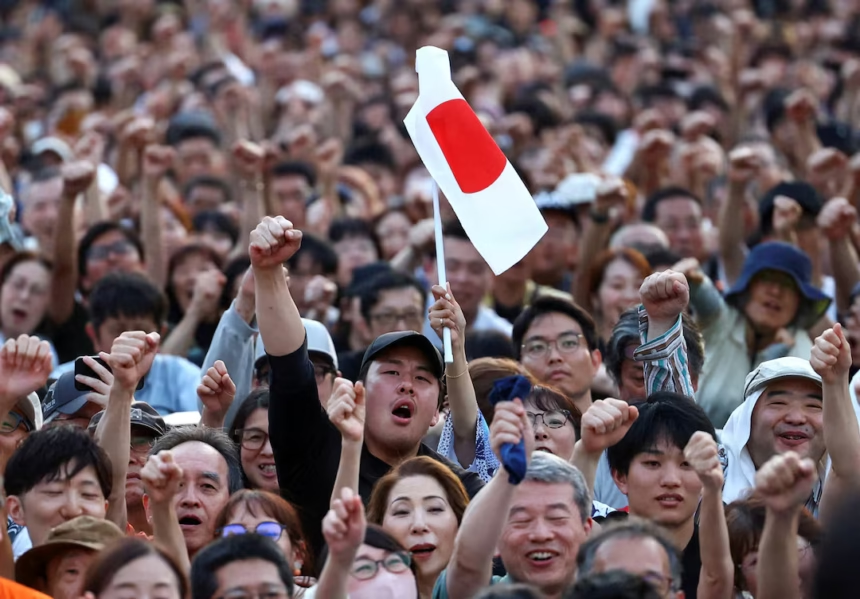The fringe far-right Sanseito party has emerged as one of the biggest winners in Japan’s upper house election on Sunday, gaining significant support with warnings of a “silent invasion” of immigrants, alongside pledges for tax cuts and welfare spending.
From YouTube to Mainstream: Sanseito’s Rise
Born on YouTube during the COVID-19 pandemic by spreading conspiracy theories about vaccinations and a cabal of global elites, Sanseito has broken into mainstream politics with its “Japanese First” campaign. The party secured 14 seats in the 248-seat upper chamber, a substantial increase from the single lawmaker it held three years ago. It currently holds only three seats in the more powerful lower house.
Sohei Kamiya, the party’s 47-year-old leader, clarified the slogan’s intent: “The phrase Japanese First was meant to express rebuilding Japanese people’s livelihoods by resisting globalism. I am not saying that we should completely ban foreigners or that every foreigner should get out of Japan.”
Setback for Ruling Coalition and Political Shifts
The rise of Sanseito comes as Prime Minister Shigeru Ishiba’s Liberal Democratic Party (LDP) and its coalition partner Komeito lost their majority in the upper house. This defeat, following a lower house loss in October, leaves the ruling coalition further reliant on opposition support. This marks the first time the LDP-led coalition has lost a majority in both houses of parliament since the party’s formation in 1955. Despite the setback, Ishiba has vowed to remain in office.
Joshua Walker, head of the U.S. non-profit Japan Society, views Sanseito’s emergence as a sign of the LDP and Ishiba’s weaknesses rather than solely the new party’s strength, noting its populist and anti-foreign sentiment.
Voter Concerns and Sanseito’s Appeal
While polling ahead of the election showed social security, declining birthrate, and rising rice prices as top voter concerns, immigration also registered as an issue for 7% of respondents. Kamiya attributed the party’s success to the public realizing that “the media was wrong and Sanseito was right” in the face of accusations of xenophobia. Political analysts suggest Kamiya’s message resonated with voters frustrated by a weak economy and a depreciating currency, which, while boosting tourism, has also driven up prices that many Japanese find increasingly unaffordable.
Japan’s rapidly aging society has seen its foreign-born resident population reach a record of about 3.8 million last year, though this constitutes only 3% of the total population, significantly lower than proportions in the United States and Europe.
Trump Inspiration and Future Alliances
Kamiya, a former supermarket manager and English teacher, has openly cited U.S. President Donald Trump’s “bold political style” as an inspiration. While right-wing populist policies have traditionally struggled to take root in Japan compared to Europe and the U.S., Sanseito’s gains suggest a potential shift. Post-election, Kamiya indicated plans to build alliances with other small parties rather than cooperate with the LDP administration, following the example of emerging populist parties in Europe.
Sanseito’s focus on immigration has already influenced Japanese politics, with Ishiba’s administration announcing a new government taskforce to combat “crimes and disorderly conduct” by foreign nationals and the LDP promising a target of “zero illegal foreigners” just days before the vote.
Kamiya, who gained notoriety for controversial remarks, including appearing to call for the emperor to take concubines, has reportedly attempted to moderate some of the party’s more extreme stances. However, he faced backlash during the campaign for branding gender equality policies as a mistake. To broaden its support beyond its core demographic of men in their twenties and thirties, Sanseito notably fielded a number of female candidates, including singer Saya, who secured a seat in Tokyo.
Like other opposition parties, Sanseito advocates for tax cuts and increased child benefits, policies that have raised concerns among investors about Japan’s fiscal health. However, its significant online presence, particularly its YouTube channel with 400,000 followers—more than any other party and triple that of the LDP—provides a powerful platform to challenge the political establishment.
Kamiya sees this upper house breakthrough as merely the beginning: “We are gradually increasing our numbers and living up to people’s expectations. By building a solid organization and securing 50 or 60 seats, I believe our policies will finally become reality.”







